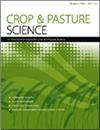Development of low-phytate maize inbred lines through marker-assisted introgression of lpa1
IF 1.9
4区 农林科学
Q2 AGRICULTURE, MULTIDISCIPLINARY
引用次数: 0
Abstract
ABSTRACT Context. Phytic acid is the major storage form of phosphorus in cereals and is considered an anti-nutritional factor because it chelates major mineral micronutrient cations, resulting in micronutrient malnutrition in humans. For monogastric animals fed maize (Zea mays L.) grains, the stored phosphorus does not release into the digestive tract, leading to phosphorus deficiency and environmental pollution. Aims. The aim of the study was to develop maize lines with a lower level of phytic acid that might substantially enhance the nutritional value of maize. Methods. The lpa1 mutant allele conferring low phytic acid was transferred into the parental lines of popular maize hybrid DMH 121 (i.e. BML 6 and BML 45) through marker-assisted backcross breeding. Foreground selection was performed using a co-dominant single nucleotide polymorphism marker through a high-resolution melting approach, and background selection was undertaken using 50–55 polymorphic sequence-tagged microsatellite site markers. Key results. Near-isogeneic lines were produced with >90% recurrent parental genome and reduction of phytic acid content by up to 44–56% compared with the original lines. Conclusions. The near-isogeneic lines carrying lpa1 can be used to reconstitute DHM 121 with low phytate content. Implications. The low-phytate maize hybrids produced can be useful in reducing micronutrient malnutrition in humans, as well as environmental pollution.标记辅助导入lpa1培育低植酸酶玉米自交系
摘要上下文。Phytic acid是谷物中磷的主要储存形式,被认为是一种抗营养因子,因为它螯合了主要的矿物质微量营养素阳离子,导致人类微量营养素营养不良。对于喂食玉米(Zea mays L.)谷物的单胃动物,储存的磷不会释放到消化道中,导致磷缺乏和环境污染。目标。本研究的目的是开发具有较低水平的植酸的玉米品系,这可能会大大提高玉米的营养价值。方法。通过标记辅助回交育种,将具有低植酸的lpa1突变等位基因转移到玉米杂交种DMH121(即BML6和BML45)的亲本系中。通过高分辨率熔解方法,使用共显性单核苷酸多态性标记进行前景选择,使用50-55个多态性序列标记的微卫星位点标记进行背景选择。关键成果。产生的近等基因系具有>90%的重复亲本基因组,并且与原始系相比,植酸含量减少了高达44–56%。结论。携带lpa1的近等基因系可用于重组具有低植酸酶含量的DHM121。含义。生产的低植酸酶玉米杂交种可用于减少人类微量营养素营养不良和环境污染。
本文章由计算机程序翻译,如有差异,请以英文原文为准。
求助全文
约1分钟内获得全文
求助全文
来源期刊

Crop & Pasture Science
AGRICULTURE, MULTIDISCIPLINARY-
CiteScore
4.20
自引率
15.80%
发文量
111
审稿时长
3 months
期刊介绍:
Crop and Pasture Science (formerly known as Australian Journal of Agricultural Research) is an international journal publishing outcomes of strategic research in crop and pasture sciences and the sustainability of farming systems. The primary focus is broad-scale cereals, grain legumes, oilseeds and pastures. Articles are encouraged that advance understanding in plant-based agricultural systems through the use of well-defined and original aims designed to test a hypothesis, innovative and rigorous experimental design, and strong interpretation. The journal embraces experimental approaches from molecular level to whole systems, and the research must present novel findings and progress the science of agriculture.
Crop and Pasture Science is read by agricultural scientists and plant biologists, industry, administrators, policy-makers, and others with an interest in the challenges and opportunities facing world agricultural production.
Crop and Pasture Science is published with the endorsement of the Commonwealth Scientific and Industrial Research Organisation (CSIRO) and the Australian Academy of Science.
 求助内容:
求助内容: 应助结果提醒方式:
应助结果提醒方式:


